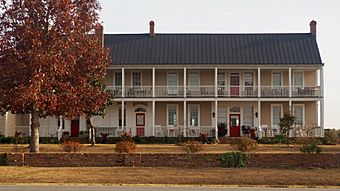Smithonia, Georgia facts for kids
Quick facts for kids |
|
|
Smithonia
|
|
 |
|
| Lua error in Module:Location_map at line 420: attempt to index field 'wikibase' (a nil value). | |
| Nearest city | Comer, Georgia |
|---|---|
| Built | 1866 |
| Architect | James Monroe Smith (Georgia planter) |
| Architectural style | Plantation Plain |
| NRHP reference No. | 84001213 |
| Added to NRHP | June 21, 1984 |
Smithonia is a small, unincorporated place in Oglethorpe County, Georgia, United States. It's found where Crawford-Smithonia Road and Smithonia Road meet. Smithonia is also the name of a large historical farm, called a plantation, which was added to the National Register of Historic Places in 1984.
This area is about three miles from Howard's Covered Bridge. The closest city to Smithonia is Comer.
Smithonia, which is near Athens, was started and named by James Monroe Smith. He was a state senator in Georgia. What began as a small farm grew into the biggest plantation in the state.
The Story of Smithonia
The land that became Smithonia was owned by James M. Smith. He was a very successful farmer and a state leader in Georgia. The main buildings were constructed in 1866. They were built in a style known as "Plantation Plain" architecture.
A special train line, called the Smith and Dunlap Railroad, connected the farm to the main Georgia Railroad at Dunlap, Georgia. This train line was also used to help build Howard's Covered Bridge.
James M. Smith's farm grew very large, stretching for about thirty miles. He used the labor of many people to make his farm successful. After the American Civil War, the way people worked changed. Smith began to use the labor of people who were in prison. Many of these workers were African Americans, including some who had been enslaved before the war, or their families.
Smith used these workers to make his farm the largest in Georgia. Workers were not allowed to leave the farm. If they tried to run away, they were brought back. They faced very harsh punishments if they tried to escape.

